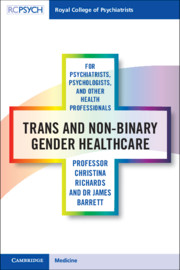Book contents
- Trans and Non-binary Gender Healthcare for Psychiatrists, Psychologists, and Other Health Professionals
- Reviews
- Trans and Non-binary Gender Healthcare for Psychiatrists, Psychologists, and Other Health Professionals
- Copyright page
- Contents
- Acknowledgements
- Author Biographies
- Chapter 1 Introduction to Gender Diversity
- Chapter 2 Assessment
- Chapter 3 Physical Treatments for Trans People and Their Interactions with Psychiatric Treatments
- Chapter 4 Mental Health Conditions
- Chapter 5 Supporting Trans and Non-binary People in Mental Health Services
- Chapter 6 Supporting Trans and Non-binary People in Forensic Settings
- Chapter 7 Autistic Spectrum Conditions and Intellectual Disability
- Chapter 8 Sexuality, Relationships, and Reproduction
- Chapter 9 Legal and Religious Aspects
- Chapter 10 Psychotherapy
- Index
- References
Chapter 1 - Introduction to Gender Diversity
Published online by Cambridge University Press: 18 August 2020
- Trans and Non-binary Gender Healthcare for Psychiatrists, Psychologists, and Other Health Professionals
- Reviews
- Trans and Non-binary Gender Healthcare for Psychiatrists, Psychologists, and Other Health Professionals
- Copyright page
- Contents
- Acknowledgements
- Author Biographies
- Chapter 1 Introduction to Gender Diversity
- Chapter 2 Assessment
- Chapter 3 Physical Treatments for Trans People and Their Interactions with Psychiatric Treatments
- Chapter 4 Mental Health Conditions
- Chapter 5 Supporting Trans and Non-binary People in Mental Health Services
- Chapter 6 Supporting Trans and Non-binary People in Forensic Settings
- Chapter 7 Autistic Spectrum Conditions and Intellectual Disability
- Chapter 8 Sexuality, Relationships, and Reproduction
- Chapter 9 Legal and Religious Aspects
- Chapter 10 Psychotherapy
- Index
- References
Summary
People who are not content to remain the gender they were assigned at birth have existed throughout human history and in all recorded cultures (Herdt, 1996). Naturally the experiences of people in the contemporary high-income cultures which are the focus of this book will be informed by the understandings and technology available now, but fundamentally gender diversity is not a new phenomenon. It is therefore curious that, until recently, it was commonly thought that gender diversity was so rare that it would not trouble most psychiatrists or psychologists in their usual course of work. This is no longer the case, as there has recently been an exponential increase in the number of gender diverse people coming forward, which mirrors that of same-sex-attracted people a couple of decades before. Most likely this is once again due to the greater, although still tenuous, social acceptance being shown towards sexual and gender diversity in some countries. It follows therefore that psychiatrists and others will have seen gender diverse people throughout their careers, but without necessarily being aware that they were doing so.
- Type
- Chapter
- Information
- Trans and Non-binary Gender Healthcare for Psychiatrists, Psychologists, and Other Health Professionals , pp. 1 - 13Publisher: Cambridge University PressPrint publication year: 2020

